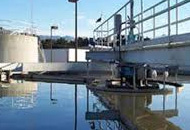
Raw Sewage Tank no 1
Input is taken from a underground sump where all the flush toilet sewage, Bathroom waste water, Kitchen waste water enters. There is a mesh which filters out non-sewage material if any. I believe a pump runs here to shred (digest) the sewage and mix it up.
Aeration Tank no 2
Input is from Raw Sewage tank. There is a media that looks like concentric circular structures in which bacteria are created These are added into the tank. The bacteria then act upon the sewage and decompose it. There are also blowers in this tank at the bottom which pump air into the system. The oxygen is necessary for the bacteria to survive, reproduce and decompose the sewage.
Secondary Settling tank no 3
Input is from tank 2 and is mainly bacteria treated sewage. This tank is at a lower level from Tank 2. So flow is natural as the sewage builds up. Alum is added. Here there are cubical columns in which the sewage -sludge settles at the bottom and the water rises up When enough volume of decomposed sewage has been built up then this is pumped back into the aeration tank as it is rich in bacteria to help decompose incoming sewage When enough volume of sewage has been built up then BBMP agency comes and takes the sewage.
Clarifying Tank no 4
Input — Water (only ) flows into this from Tank 3. It will still contain some particulate matter. This is allowed to settle here and the clarifying process is completed. filtrations: from the above tank, clarified water is passed through two filters. Filter 1:- Sand and Filter 2:- Activated Carbon Filter.
Treated Water tank:
Input is from Tank 4 via the filters. Chlorine is added to the water (online) and this water is called as the STP Treated water. It is the main output from the plant. The benefits however are tremendous. You save a lot of water for the community. The treated water can be used for watering plants and for the flush system. If the BOD levels continue to remain low then this water can be used for car wash as well.
Benefits and Problem Shooting:
(a) There are various events that stop/affect the organic process:
(i) plastic media get stuck at the bottom of the settling tank or aeration tank and damage the respective motor of the pump.
(ii) Bacteria concentration has to be monitored regularly otherwise decomposing will not happen and actual watery sewage might flow into the clarifying tank.
(iii) It is important to ensure the capacity of the plant is not crossed.
(iii) In the treated water tank the water cannot be left lying for a long time. It will start to stink as the cholrine which controls bacterial activity starts to evaporate.
(iv) Monthly test reports have to be monitored very closely. There is a parameter called BOD – Biological Oxygen Demand, this has to be low. If it is then your plant is working very well.
(v) if you are funneling the treated water back into your flush system then the builder’s pipe connections must be checked thoroughly. . Also residents need to be alert and cooperative for the flush water might smell a bit sometimes and if left for long might turn turbid.